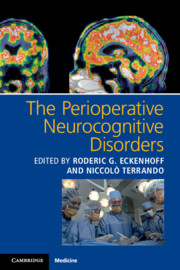Book contents
- The Perioperative Neurocognitive Disorders
- Reviews
- The Perioperative Neurocognitive Disorders
- Copyright page
- Contents
- Contributors
- Preface
- Section 1 Cognitive Function in Perioperative Care
- Chapter 1 Emergence Delirium
- Chapter 2 Postoperative Delirium
- Chapter 3 Postoperative Cognitive Dysfunction
- Chapter 4 Postoperative Cognitive Improvement
- Chapter 5 Persistent Perioperative Neurocognitive Disorder
- Section 2 Pathophysiology of the Perioperative Neurocognitive Disorders
- Section 3 Symptomatology and Diagnosis for the Perioperative Neurocognitive Disorders
- Section 4 Clinical Recommendations and Prevention
- Index
- Plate Section (PDF Only)
- References
Chapter 4 - Postoperative Cognitive Improvement
from Section 1 - Cognitive Function in Perioperative Care
Published online by Cambridge University Press: 11 April 2019
- The Perioperative Neurocognitive Disorders
- Reviews
- The Perioperative Neurocognitive Disorders
- Copyright page
- Contents
- Contributors
- Preface
- Section 1 Cognitive Function in Perioperative Care
- Chapter 1 Emergence Delirium
- Chapter 2 Postoperative Delirium
- Chapter 3 Postoperative Cognitive Dysfunction
- Chapter 4 Postoperative Cognitive Improvement
- Chapter 5 Persistent Perioperative Neurocognitive Disorder
- Section 2 Pathophysiology of the Perioperative Neurocognitive Disorders
- Section 3 Symptomatology and Diagnosis for the Perioperative Neurocognitive Disorders
- Section 4 Clinical Recommendations and Prevention
- Index
- Plate Section (PDF Only)
- References
- Type
- Chapter
- Information
- The Perioperative Neurocognitive Disorders , pp. 34 - 47Publisher: Cambridge University PressPrint publication year: 2019



